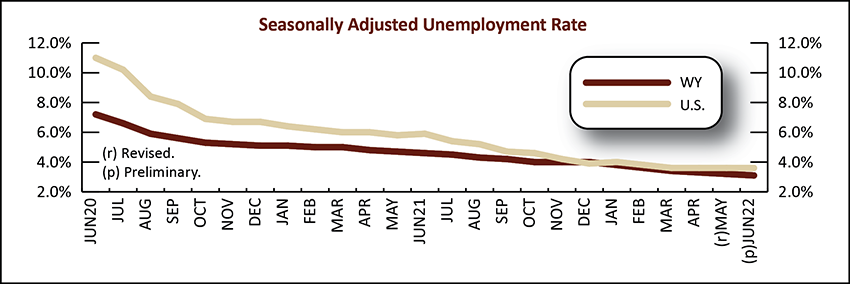Wyoming Labor Force Trends
August 2022 | Volume 59, No. 8
Click Here for PDF
Return to Table of Contents
News Release: Wyoming Unemployment Falls to 3.1% in June 2022
by: David Bullard, Senior Economist
The Research & Planning section of the Wyoming Department of Workforce Services reported that the state’s seasonally adjusted1 unemployment rate decreased from 3.2% in May to 3.1% in June. Wyoming’s unemployment rate peaked at 8.6% in May 2020, and it has been gradually falling since then. The U.S. unemployment rate stood at 3.6% in June, and has remained at that level since March. Unemployment in Wyoming has been lower than the U.S. each month of 2022.
From May to June, most county unemployment rates followed their normal seasonal pattern and rose slightly. Unemployment rates sometimes increase in June as young people get out of school and start looking for work. The largest increases occurred in Lincoln (up from 2.9% to 3.7%), Albany (up from 2.5% to 3.1%), Goshen (up from 2.3% to 2.9%), Sweetwater (up from 3.6% to 4.2%), and Uinta (up from 3.3% to 3.9%) counties. Teton County’s unemployment rate fell from 3.3% to 2.2% as employers hired for the summer tourist season.
From June 2021 to June 2022, unemployment rates fell in every county. Large decreases were seen in Natrona (down from 6.7% to 4.0%), Converse (down from 5.4% to 2.9%), Campbell (down from 6.1% to 3.6%), and Sublette (down from 6.2% to 3.8%) counties. Unemployment rates were unusually high in 2021 because of the pandemic, and recent decreases reflect a return to more normal levels.
Sweetwater County, at 4.2%, posted the highest unemployment rate in June. It was followed by Natrona County at 4.0% and Uinta County at 3.9%. The lowest unemployment rates were found in Teton County and Niobrara County (both at 2.2%). The next lowest rates were reported in Weston County at 2.5% and Crook County at 2.6%.
Total nonfarm employment in Wyoming (not seasonally adjusted and measured by place of work) rose from 285,600 in June 2021 to 291,800 in June 2022, an increase of 6,200 jobs (2.2%). Employment was unusually low in 2021 because of economic disruptions related to the pandemic.
R&P's most recent monthly news release is available at https://doe.state.wy.us/LMI/news.htm.




.svg)
 Wyoming at Work
Wyoming at Work